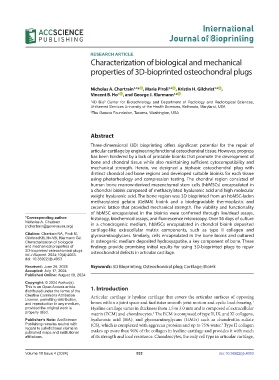Page 540 - IJB-10-4
P. 540
International
Journal of Bioprinting
RESEARCH ARTICLE
Characterization of biological and mechanical
properties of 3D-bioprinted osteochondral plugs
Nicholas A. Chartrain * , Maria Piroli 1,2 id , Kristin H. Gilchrist 1,2 id ,
1,2 id
Vincent B. Ho 1 id , and George J. Klarmann 1,2 id
1 4D Bio³ Center for Biotechnology and Department of Radiology and Radiological Sciences,
Uniformed Services University of the Health Sciences, Bethesda, Maryland, USA
2 The Geneva Foundation, Tacoma, Washington, USA
Abstract
Three-dimensional (3D) bioprinting offers significant potential for the repair of
articular cartilage by engineering functional osteochondral tissue. However, progress
has been hindered by a lack of printable bioinks that promote the development of
bone and chondral tissue while also maintaining sufficient cytocompatibility and
mechanical strength. Herein, we designed a biphasic osteochondral plug with
distinct chondral and bone regions and developed suitable bioinks for each tissue
using photorheology and compression testing. The chondral region consisted of
human bone marrow-derived mesenchymal stem cells (hbMSCs) encapsulated in
a chondral bioink composed of methacrylated hyaluronic acid and high molecular
weight hyaluronic acid. The bone region was 3D bioprinted from an hbMSC-laden
methacrylated gelatin (GelMA) bioink and a biodegradable thermoplastic and
ceramic lattice that provided mechanical strength. The viability and functionality
of hbMSC encapsulated in the bioinks were confirmed through live/dead assays,
*Corresponding author: histology, biochemical assays, and fluorescence microscopy. Over 56 days of culture
Nicholas A. Chartrain
(nchartrain@genevausa.org) in a chondrogenic medium, hbMSCs encapsulated in chondral bioink deposited
cartilage-like extracellular matrix components, such as type II collagen and
Citation: Chartrain NA, Piroli M, glycosaminoglycans. Similarly, cells encapsulated in the bone bioink and cultured
Gilchrist KH, Ho VB, Klarmann GJ.
Characterization of biological in osteogenic medium deposited hydroxyapatite, a key component of bone. These
and mechanical properties of findings provide promising initial results for using 3D-bioprinted plugs to repair
3D-bioprinted osteochondral plugs. osteochondral defects in articular cartilage.
Int J Bioprint. 2024;10(4):4053.
doi: 10.36922/ijb.4053
Received: June 26, 2024 Keywords: 3D Bioprinting; Osteochondral plug; Cartilage; Bioink
Accepted: July 17, 2024
Published Online: August 19, 2024
Copyright: © 2024 Author(s).
This is an Open Access article 1. Introduction
distributed under the terms of the
Creative Commons Attribution Articular cartilage is hyaline cartilage that covers the articular surfaces of opposing
License, permitting distribution,
1
and reproduction in any medium, bones within a joint space and facilitates smooth joint motion and cyclic load-bearing.
provided the original work is Hyaline cartilage varies in thickness from 1.5 to 3.0 mm and is composed of extracellular
properly cited. matrix (ECM) and chondrocytes. The ECM is composed of type II, IX, and XI collagens,
2
Publisher’s Note: AccScience hyaluronic acid (HA), and glycosaminoglycans (GAGs) such as chondroitin sulfate
Publishing remains neutral with (CS), which is complexed with aggrecan proteins and up to 75% water. Type II collagen
3
regard to jurisdictional claims in
published maps and institutional makes up more than 90% of the collagen in hyaline cartilage and provides it with much
affiliations. of its strength and load resistance. Chondrocytes, the only cell type in articular cartilage,
Volume 10 Issue 4 (2024) 532 doi: 10.36922/ijb.4053

